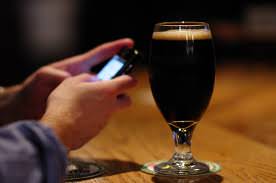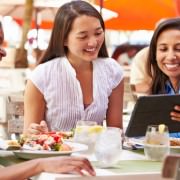Ordering a Drink? There’s an App for That.
These days, there’s nothing new about using technology to help expedite the process of ordering food at a restaurant. Once waitstaff at some restaurants started sending orders back to the kitchen using hand-held devices, it was only a matter of time before similar technology made it directly into the hands of customers – most commonly now through online delivery apps like Seamless and GrubHub. Today, some airline passengers, while they wait to board at the gate area, may even use iPad menus to order, with the assurance that their items will be brought directly to them within minutes.
Now, starting this past fall, some pub-goers in the U.K. no longer have to crowd around the bar and scream to have their drink orders heard, reserving their vocal cords for more friendly uses. London’s Daily Mail has reported that a new mobile app, debuting at the Keyworth Tavern in Nottingham (before being set for use nationwide), allows customers to order from their seats, receiving updates on the progress of their orders as they wait.
We’ve seen similar apps in the United States trying to do the same for a long time. Apps keep coming and going, like Flowtab, BarTab, DrinkPass, Coaster, and many more.
While many have initially balked at the thought of the app, citing an apparent lack of human interaction in the ordering process, the overall reaction has actually been quite the opposite: finally, instead of having to cut friendly conversations short in order to vie for the busy bartender’s attention, one can actually do more socializing with fellow bar patrons, not less. Besides, a real, live, friendly person (possibly a less flustered one) will still be the one delivering drinks to the table.
What is more, apps now makes it possible to place drink orders remotely, too. One thing this means is that customers who can’t make it for a night out on the town can still treat a friend to a drink – or even break the ice with someone they’ve spotted from across the bar (but haven’t yet had the courage to say say hello to in person). Patrons can now even have a cold round waiting for them upon arrival.
The challenge for these apps is getting enough consumers to use them to make it worthwhile for the bar. If only a couple people use the app to order each night, it hardly seems worth it to implement the mobile ordering solution. From the mobile company side, they need to integrate with dozens of different point of sale systems, making it no trivial task to ensure the mobile ordering app works everywhere.
The question remains, will one of these apps win out in the end and reduce the time consumers wait for ordering a drink at a bar? Or are they trying to solve something that just doesn’t pain enough people to pay for it?
- Uncorkd Adds New Vendor Purchasing, Tracking and Reporting Functionality - February 13, 2018
- Uncorkd Adds New Inventory Management Functionality with POS Integration - July 24, 2017
- How Many Red or White Wines Should You Have on Your List - May 3, 2016




